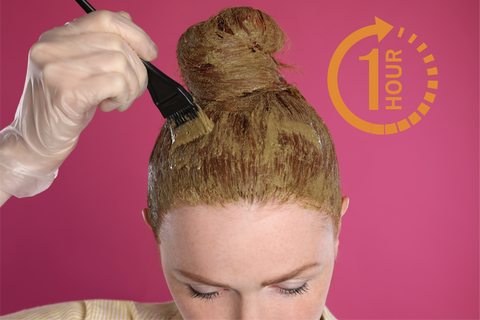Article updated on: March 28, 2025
Why Won’t My Hair Take Color?
Few things are as disappointing as spending time and money on hair coloring only to find the dye doesn’t take as expected. If you’re wondering why your hair isn’t embracing the color, read on for some common reasons and helpful tips. In fact, the most common cause appears to be what we refer to as issue number 8—excessively damaged hair that hinders color retention. Keep reading to uncover the full story and discover how to achieve vibrant, long-lasting results.
1. Insufficient Processing Time

- Problem: Rushing through the dye process means the natural pigments don’t have enough time to fully penetrate your hair’s cuticle.
- Solution: Let your dye sit for 45 to 60 minutes. If your hair resists color absorption, aim for the longer end of the time range.
2. Incorrect Paste Consistency

- Problem: Hair typically absorbs water up to about 18% of its weight. If your paste is too thick, there isn’t enough moisture for the water to penetrate deeply into your hair, leading to poor dye absorption.
- Solution: Mix your dye to a consistency similar to ketchup or yogurt—thick enough to stay on your hair without dripping, yet fluid enough to spread evenly.
3. Dirty Hair

- Problem: Natural dyes are more sensitive to dirt compared to chemical dyes. Dirt can block color from properly adhering to your hair.
- Solution: Always use an natural shampoo to thoroughly clean your hair before applying any natural dye.
4. Excessive Greasiness

- Problem: While a bit of natural oil protects your hair, too much can cause the dye to slide off, leading to uneven or weak color.
- Solution: Ensure your hair isn’t overly oily before dyeing. A quick wash with a mild shampoo can help strike the right balance.
5. Silicone-Based Products

- Problem: Shampoos and conditioners containing silicone form a barrier on your hair that prevents natural pigments from penetrating.
- Solution: Avoid silicone-infused products when you plan to use natural hair dyes.
6. Hard Water Issues

- Problem: Hard water contains minerals like calcium and magnesium, which can form a film on your hair that blocks color absorption.
- Solution: Consider using a water softener or a clarifying rinse before dyeing.
7. Porosity Challenges: Balancing Low and Excessive Porosity


- Problem: Hair that is too low in porosity (with tightly sealed cuticles) struggles to absorb natural dyes, while excessively damaged, overly porous hair may initially take up color but then lose it quickly as the pigment washes out.
- Solution: Pre-washing your hair helps open the cuticles, and using a weakly alkaline soap shampoo further promotes this process, enhancing dye penetration. For hair that’s overly porous due to damage, focus on repairing and restoring its health before dyeing to achieve more lasting results.
8. Overwashing and Color Fixation

- Problem: Overwashing after dyeing can prevent the herbal pigment particles from fully settling in your hair. These particles need 2 to 3 days to penetrate deeply and fix the color. If you wash your hair too frequently—especially to remove the lingering grassy scent—you might mistakenly wash away the vital pigments before they have a chance to set, leading to poor color development.
- Solution: Allow your hair at least 3 days to fully fix the color before washing it thoroughly. This period lets the natural herbal pigments bond with your hair, ensuring a vibrant, lasting hue. Once the color is set, you can wash your hair without worrying about color loss.
Our Recommendations:
The moments just before and immediately after dyeing are crucial—especially right after your hair is colored. This is when color fixation is most sensitive. Although you might still notice a lingering scent, avoid washing your hair too vigorously right after dyeing. During this time, the natural herbal pigment particles inside your hair are prone to washing out. Since hair can absorb up to about 18% of its weight in water, this absorbed moisture evaporates as your hair dries. However, as water leaves, it can also carry away the vital plant-based particles that need to set within your hair. This initial period is essential for the pigment particles to properly bond with your hair, so we recommend only a gentle rinse during this time for optimal color retention.
By understanding these factors and taking the necessary steps, you can achieve a more satisfying natural hair dye experience. Happy coloring!
